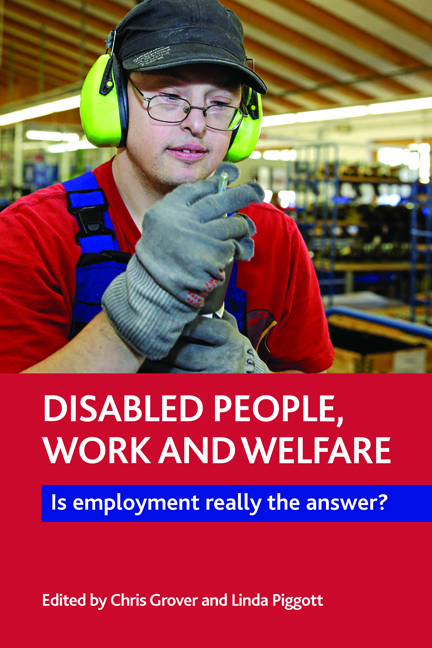Book contents
- Frontmatter
- Dedication
- Contents
- List of tables and figures
- List of abbreviations
- Notes on contributors
- Acknowledgements
- one Disabled people, work and welfare
- Part One Changing constructions of disability and welfare
- Part Two Social policy, work and disabled people
- Part Three Assistance and access to paid work
- Part Four Alternatives to, and validated lives beyond, paid work
- Part Five Conclusion
- Index
five - Disabled people, welfare reform and the balance of rights and responsibilities
Published online by Cambridge University Press: 11 March 2022
- Frontmatter
- Dedication
- Contents
- List of tables and figures
- List of abbreviations
- Notes on contributors
- Acknowledgements
- one Disabled people, work and welfare
- Part One Changing constructions of disability and welfare
- Part Two Social policy, work and disabled people
- Part Three Assistance and access to paid work
- Part Four Alternatives to, and validated lives beyond, paid work
- Part Five Conclusion
- Index
Summary
Introduction
The increased conditionality that has been the hallmark of recent reform of benefits for disabled people in Britain has been justified, often explicitly, on the grounds that those disabled people required to seek work will be given appropriate support. Through a series of qualitative interviews with policy makers and a review of relevant literature and qualitative data, this chapter seeks to examine the extent to which increased conditionality has been accompanied by increased support for disabled people to access paid work. The chapter argues that what began in the mid-2000s as a genuine attempt to extend employment support to disabled people marginalised from the paid labour market has faded in recent years. This appears to be as a result of changed labour market policy priorities as a result of the economic crisis that began in 2008 and the failure of the Pathways to Work programme (PtW). The Work Programme (WP) that was, at least in part, a replacement for PtW, however, makes limited formal recognition of the additional labour market barriers that disabled people face and does little to stop disabled people from being excluded by service providers.
Concurrently, welfare reform has continued apace, with 900,000 people with disabilities or health conditions experiencing some additional conditionality (Beatty and Fothergill, 2011). Unlike, for example, in Scandinavian countries, where benefits reform has been bound up closely with and accepted by social partners in exchange for improved support, disabled people claiming working-age benefits in Britain have few formal rights to employment services or to redress if excluded from them. Looked at this way – as an (im)balance between permanent changes in the value and conditions of benefits with services of highly variable availability and quality – reform of working-age disability benefits emerges as even more punitive than has hitherto been appreciated.
The rest of this chapter is divided into five sections. The first section explores the nature of the welfare settlement between the state and disabled working-age benefit claimants that emerged in the 2000s – one supposedly underpinned by the state and the claimants’ mutual rights and responsibilities. The second section examines the subsequent shift from small-scale specialist employment support to more mainstream employment support for a much larger group of disabled claimants. Marshalling relevant evidence, the third section judges the adequacy of this type of support in the WP according to three offered criteria:
• access;
• quality and availability;
- Type
- Chapter
- Information
- Disabled People, Work and WelfareIs Employment Really the Answer?, pp. 87 - 104Publisher: Bristol University PressPrint publication year: 2015

